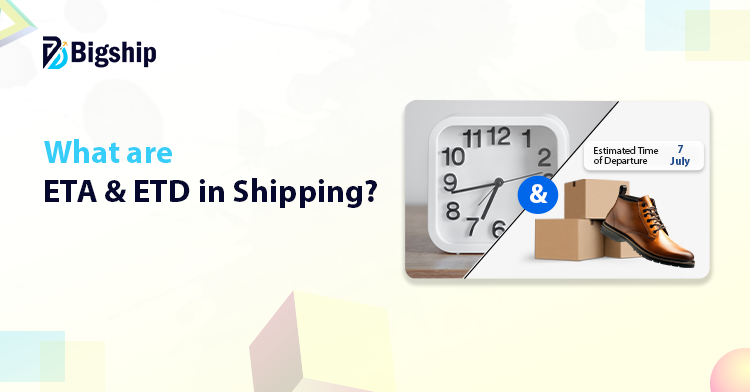Ever wondered how your package makes it from one part of the world to your doorstep on time? That’s where ETA and ETD come in. In simple words, ETA meaning in shipping is the Estimated Time of Arrival, which tells you when a shipment is expected to reach its destination. On the other hand, ETD full form in airport stands for Estimated Time of Departure, which tells when a flight or cargo is set to leave. These terms may look small, but they play a big role in keeping global trade, travel, and deliveries smooth, fast, and predictable.
In this blog, we’ll break down the ETD & ETA meanings in logistics and explain why they matter in shipping and supply chain operations.

What is ETA in Shipping?
ETA full form in shipping is Estimated Time of Arrival. It tells you when your cargo is expected to reach the destination. You usually get this time from the shipping company.
ETA meaning in logistics is simple. It helps you track the shipment better. You don’t have to guess when the goods will come. You already know the expected date and time.
This time is not random. The shipping company checks the current location of the vessel. They also check how fast it’s moving. Then they look at weather, port traffic, and customs delays. After that, they give you an estimated time.
Let’s say your goods are leaving Mumbai port on May 5. The vessel is going to Dubai. The carrier tells you the ETA is May 10 at 2 PM. This means your cargo will likely reach Dubai port by that time.
What is ETD in Shipping?
ETD full form in shipping is Estimated Time of Departure. It means the date and time your shipment is expected to leave the port.
This helps you plan better. If you know when your cargo leaves, you can guess when it might reach the destination. It also helps you check if there are any delays.
ETD full form in airport is the same. It means the time a flight is expected to take off. In both cases, it gives you a clear idea of the starting point.
Let’s take an example. Your goods are ready in Chennai. The shipping company tells you the ETD is May 7 at 9 AM. This means your cargo will leave the port on that date and time.
Difference between ETA and ETD
ETA and ETD are two common terms in shipping. You see them while sending or receiving goods. ETA meaning is about when something arrives. ETD full form tells you when something leaves. Both help you track your shipment better.
| ETA | ETD |
| The ETA full form in logistics is Estimated Time of Arrival. | The ETD full form is Estimated Time of Departure. |
| ETA shows the time and date a shipment is expected to arrive. | ETD tells the time and date a shipment is expected to leave. |
| ETA focuses on the receiving side. | ETD focuses on the sending side. |
| People waiting for goods often look at the ETA. | People shipping goods usually check the ETD. |
How to Calculate ETA in Shipping?
ETA tells you the expected date and time your shipment will reach its destination. You don’t need complex tools to get a rough ETA. Just follow a few simple steps.
Note the Departure Time: First, find out the ETD. This is the Estimated Time of Departure. It shows when the shipment leaves the port or location.
Check the Transit Time: Next, calculate how long the shipment will take to reach the destination. This depends on distance, mode of transport, route, and weather.
Add Both Values: Now add the departure time and the transit time. The result is your ETA.
Formula:
ETA = ETD + Transit Time
Consider Extra Delays: Sometimes, delays can happen. These may be due to customs checks, bad weather, or port traffic. Keep some buffer time in mind.
How is ETD Determined in Logistics?
ETD tells you when the shipment is expected to leave the starting point. This time is not random. It depends on a few important things.
Carrier Schedule: Shipping companies follow fixed schedules. They set the departure time based on that timetable.
Booking Confirmation: ETD is final only after the booking is confirmed. Once space is booked on the vessel, flight, or truck, the time becomes official.
Port or Terminal Availability: If the port is busy, the departure may get delayed. So, port traffic plays a big role in setting the ETD.
Customs and Clearance Checks: Goods must be cleared before they leave. Any delay in documentation or inspection can shift the ETD.
Weather Conditions: Bad weather may push the departure time forward. Carriers adjust the ETD if storms or other conditions affect travel.
Cargo Readiness: If the shipment is not packed or ready on time, the carrier may wait or reschedule. This affects the final ETD.
Why ETA and ETD Matter in Supply Chain?
ETA and ETD keep everything in the supply chain on track. When you know when things will arrive and leave, it’s easier to plan, move, and deliver goods on time.
Reduces delays: ETA and ETD help you avoid waiting time at ports, warehouses, or delivery centers.
Improves planning: If you know when goods are arriving or leaving, you can plan your team, transport, and space better.
Keeps customers happy: Accurate ETA helps you promise real delivery dates to your buyers.
Saves cost: Clear ETD lets you manage trucks, storage, and labor better. This saves extra charges and handling costs.
Reduces congestion: Ports and warehouses need proper ETD and ETA to manage traffic. This avoids pile-ups and confusion.
What are the challenges in predicting ETA?
Predicting the exact ETA (Estimated Time of Arrival) isn’t always easy. Many things can go wrong along the way. Here are a few common challenges that can affect ETA:
Busy Roads Slow Things Down: Most deliveries happen in cities where traffic is heavy. Jam-packed roads often cause delays. Even if the package is ready to go, it might not reach on time because vehicles get stuck, especially during peak hours.
Unclear or Incomplete Addresses: When customers don’t give full or correct delivery addresses, it creates confusion. Delivery agents waste time finding the right location, or worse, the package might go to the wrong place.
Manual Parcel Handling Takes Time: In many warehouses, parcels are still sorted by hand. Workers separate packages based on routes, size, and destination. If the staff is overworked or there’s a backlog, it slows down the whole process.
Weather Can Be Unpredictable: Bad weather is a big reason for delayed deliveries. Heavy rain, snow, storms, or fog can stop or slow down vehicles, flights, and even ships. This directly affects when the package will reach its destination.
Benefits of Accurate ETA in Shipping
When you know exactly when a shipment will arrive, everything runs smoother. Accurate ETA (Estimated Time of Arrival) helps both businesses and customers in many ways. Here’s how:
Satisfied Customers: When people know when their order will arrive, they feel more in control. Timely deliveries reduce confusion and build trust.
Better Stock Planning: Accurate ETAs help warehouses manage inventory better. It prevents running out of stock or keeping too much. This keeps everything balanced and saves money.
Lower Delivery Costs: If you know when things will arrive, you don’t need to spend extra on rush handling or storage. Fewer last-minute changes mean fewer extra charges and smoother operations.
Smarter Delivery Routes: With clear ETAs, delivery routes can be planned better. This saves fuel, avoids long waits, and makes sure each vehicle is used properly.
Fewer Delivery Problems: Late or missed deliveries cause trouble. Accurate ETAs reduce the chances of failed attempts, extra trips, and unhappy customers.
Conclusion
ETD and ETA in shipping play a critical role in managing logistics and keeping customers happy. They help businesses plan better and prevent delays. Accurate timings ensure that shipments arrive on time, thus making the process more efficient.
Bigship helps businesses stay on top of their logistics. By providing accurate ETA and ETD tracking, Bigship helps reduce delays and improve operations. So, sign up with Bigship and know the precise timing of your shipment, as it makes logistics simpler and more predictable for your business.
FAQs
What does international shipment tracking mean?
It means keeping an eye on your package as it travels from one country to another. You can see updates at every major step.
How can I track international shipments easily?
Use the tracking number provided by your shipping company. Enter it on their website or tracking page to see updates.
Does Bigship offer international shipping tracking?
Yes. Bigship lets you track international shipments from pickup to delivery, so you stay updated every step of the way.
Do all carriers offer international shipping tracking?
Most of them do, but not all tracking systems are accurate. Choose a reliable carrier for better tracking updates.





